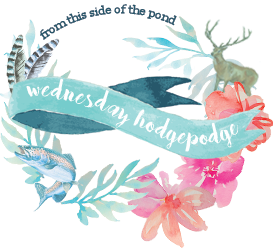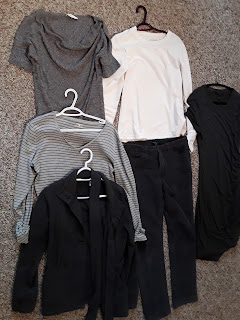Rolling into another week with the Wednesday Hodgepodge. Answer the questions on your own blog, then hop back to From This Side of the Pond to share answers with the whole wide world. Here we go-
1. Last time you moved house? Something you've learned in moving house?
We moved from a house to an apartment in 2017, and from the apartment to a townhouse a year ago last week. Our youngest Squirreling is preparing to depart from the nest soon.
Something we've learned? That a good moving company can be totally worth it, even if the move isn't far away. And that stuff always takes more boxes than you think.
If you get the chance, measure the cupboards, figure out what will fit where, and see if it would help to adjust some of them, or if you're going to have to leave something behind.
Also, if you're moving into or out if a place with an elevator, buy one of those flat carts with a tall handle like the package deliverers use. We found ours at a home store, I think. Saves carrying boxes.
2. Move mountains, move along, make a wrong move, moved to tears, get a move on, move up, move over, move out of the way, move the deck chairs on the Titanic, move it!...pick one and tell us how it fits your recent circumstances.
I moved some books and clothes along to the thrift store last week.
Here's a moving-along quote from Elizabeth Goudge:
The barn was facing them, and the old storm-twisted oak tree bent over the ate to lay its branches on the roof of the old barn. It was studded with new green leaves, coral-tipped, and they made a sort of canopy over the gate. Ben was out of the car in a flash and had opened it.
"Always thought this gate led to into a farmyard," said George as he drove forward.
"I didn't," said Caroline softly. "I always had a feeling it led somewhere wonderful, but I was afraid to go and see, in case it didn't." (Pilgrim's Inn)
3. What have you been doing to make yourself move (aka stay fit-active) during these strange times?
I am not an exerciser anyway so I am not missing gyms. I just do my normal.
4. This week's calendar includes celebrations for the following foods-
National Coffee Milkshake Day (Sunday), National Creme Brûlée Day (Monday), National Milk Chocolate Day (Tuesday), National Chicken Wing Day (Wednesday), National Lasagne Day (Wednesday), National Cheesecake Day (Thursday), and National Avocado Day (Friday)
Which one on the list would you be most inclined to celebrate? Which would you be most inclined to skip?
You missed National Lipstick Day, today! Which is a complete bummer in summer 2020, unless maybe you do Zoom calls every day.
My favourite right now, when I do get to not have something over my face: Annabelle's Brigitte
(My husband said, "Are you supposed to eat the lasagna wearing lipstick?")
Jettison
Ugly
Lipsticks
Yearly
6. Insert your own random thought here.
Today's project, besides regular work, is taking in a thrifted grey plaid skirt with buttons down the front. I take a US/Canada size 8, but I liked this one enough to buy a 13 (whatever that is). I'm trying to do this one right (instead of doing a couple of lazy waistband tucks), so I've unhemmed it, picked off two ugly patch pockets which were going to half-disappear anyway, and the next step is to trace an existing skirt, open up the waistband a bit, and sew new side seams. And re-do the hem. For me and my "evil sewing machine," that's a lot. Stay tuned to see if it's a miss or a go.
It's not perfect, but it's wearable.


















































